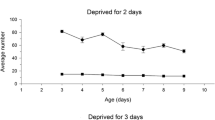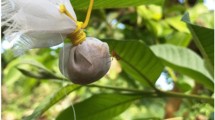Abstract
Laboratory studies of the arrhenotokous braconid wasp,Microctonus aethiops (Nees) were conducted relative to maximizing parasitoid production without adversely affecting sex ratios of the progeny.
The influence of hostHypera postica (Gyllenhal) and parasitoid densities on parasitoid productivity was evaluated. Maximum production or a mean 25.8M. aethiops progeny were obtained per female when the host parasitoid ratio was 50∶1. More than one parasitoid per rearing cage resulted in fewer parasitoid progeny per female and increased host mortality.
Oviposition significantly increased when female parasitoids were exposed to 25 different weevils every 24 hours. The most intense ovipositional activity usually occurred during the first 48 hours of exposure. However, superparasitism occurred if exposure to 25 hosts continued for more than 24 hours.
Continuous and discontinuous oviposition patterns did not affect the numbers of parasitoid progeny produced. However, fewer females were produced when new weevils were provided every 24 hours as in the continuous oviposition group.
Résumé
Des études de laboratoire sur le braconide arrhenotoque,Microctonus aethiops (Nees) ont été conduites de façon à porter au maximum la production du parasitoïde sans affecter la proportion des sexes de la progéniture.
L'influence de l'hôteHypera postica (Gyllenhal) et des densités en parasitoïdes sur la productivité de celui-ci a été évaluée. La production maximum, soit une descendance moyenne de 25.8M. aethiops par femelle, a été obtenue avec le rapport de l'hôte-parasitoïde: 50/1. Plus d'un parasitoïde par cage d'élevage a donné moins de progéniture par femelle et a augmenté la mortalité de l'hôte.
La ponte a augmenté significativement en exposant les parasitoïdes femelles à 25 charançons différents toutes les 24 heures. L'activité de ponte la plus intense est enregistrée d'habitude durant les premières 48 heures d'exposition. Cependant un superparatisisme se manifeste si l'exposition à 25 hôtes dure plus de 24 heures.
Des rythmes d'oviposition continue et discontinue n'ont pas affecté le nombre de parasitoïdes produits. Cependant, moins de femelles sont obtenues quand de nouveaux charançons sont fournis toutes les 24 heures dans les essais de ponte continue.
Similar content being viewed by others
References
Clausen, C. P. — 1939. The effect of host size upon sex ratio of hymenopterous parasites and its relations to methods of rearing and colonization. —J. N. Y. Entomol. Soc., 47, 1–9.
Coles, L. &Puttler, B. — 1963. Status of the alfalfa weevil biological control program in the eastern United States. —J. econ. Entomol., 56, 609–611.
Day, W. H., Coles, L. W., Stewart, J. A. &Fuester, R. W. — 1971. Distribution ofMicroctonus aethiops andM. colesi, parasites of the alfalfa weevil in the eastern United States. —J. econ. Entomol., 64, 190–193.
Finney, G. L. &Fisher, T. W. — 1964. Culture of entomophagous insects and their hosts.In: Biological Control of Insect Pests and Weeds (P. DeBach ed.). —Reinhold, New York, pp. 328–355.
Flanders, S. E. — 1939. Environmental control of sex in hymenopterous insects. —Ann. entomol. Soc. Amer., 32, 11–26.
Loan, C. C. — 1960. The biology of insect parasites of the genusSitona Germar [Coleoptera: Curculionidae]. —Thesis Univ. Minesota, PH. D. dissertation, Dept. of Entomol. Fisheries & Wildlife, 169 p.
Neal, J. W., Jr. — 1970. A study ofMicroctonus aethiops (Nees) a Braconid parasite of the alfalfa weevil,Hypera postica (Gyllenhal). —Thesis Univ. Maryland PH. D. dissertation, Dept. of Entomol., 92 p.
Van den Bosch, R., Finner, G. L. &Lagace, C. F. — 1971. Egyptian alfalfa weevil, biological control possibilities. —Calif. Agric., 25, 6–7.
Author information
Authors and Affiliations
Additional information
Authorized for publication April 4, 1973, as paper No. 4420 in the journal series of the Pennsylvania Agriculture Experiment Station.
Rights and permissions
About this article
Cite this article
Fusco, R.A., Hower, A.A. Influence of parasitoid-host density and host availability on the laboratory propagation ofMicroctonus aethiops [Hym.: Braconidae] parasitoid ofHypera postica [Coleop.: Curculionidae] . Entomophaga 19, 75–83 (1974). https://doi.org/10.1007/BF02371511
Issue Date:
DOI: https://doi.org/10.1007/BF02371511




